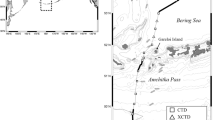Abstract
This study was designed to examine effects of low dissolved oxygen on finfish, lobster, and squid under field conditions in western Long Island Sound. The relationship between bottom dissolved oxygen (DO) and catch was examined for effects on abundance, numbers of species, and mean length, for trawl sites throughout the sound. Examination of mean catch per tow, and species number per tow, showed that both abundance and diversity decreased markedly with bottom DO, with dramatic declines at sites with DO<2 mg l−1. Of 18 species examined, 15 were found to occur with greater frequency at sites with DO>3 mg l−1 compared to sites with <2 mg l−1, and three of these species occurred significantly less frequency at a DO of 2–3 mg l−1. Trawl samples taken in the Narrows west of Greenwich, an area which chronically experiences summer hypoxia (DO<3 mg l−1) consistently yielded below average species number during hypoxic events. However, when DO was>3 mg l−1, 13 of 14 tows had above average species number. Abundance of five common species at sites>3 mg l−1 DO were significantly higher than at sites <3 mg l−1 DO in this area. Lobster was the only species not showing this DO threshold. Patterns in abundance vs DO for squid, bluefish, and butterfish suggest that these species are among the most sensitive to hypoxia. Only one of the four examined species, winter flounder, showed a decrease in mean length with DO. Scup, bluefish, and lobster lengths did not vary significantly with respect to dissolved oxygen.
Similar content being viewed by others
Literature Cited
Bejda, A., B. Phelan, and A. Studholme. 1992. The effect of dissolved oxygen on growth of young-of-year winter flounder, (Pseudopleuronectes americanus). Environmental Biology of Fishes 34:321–327.
Chapman, C. 1986 Ambient water quality criteria for dissolved oxygen. United States Environmental Protection Agency. Office of Water Regulations and Standards. Washington, D.C. EPA 440/5-86-003.
Cooper, S. and G. Brush. 1991. Long-term history of Chesapeake Bay anoxia. Science 254:992–996.
Coutant C. 1985. Striped bass, temperature, and dissolved oxygen: A speculative hypothesis for environmental risk. Transactions American Fisheries Society 114:31–61.
Dawson, M. 1990. Blood chemistry of the windowpane flounder (Scophthalmus aquosus) in Long Island Sound: Geographical, seasonal, and experimental variations. Fishery Bulletin 88: 429–437.
Garlo, E., C. Milstein, and A. Jahn. 1979. Impact of hypoxic conditions in the vicinity of Little Egg Inlet, New Jersey in summer 1976. Estuarine and Coastal Marine Science 8:421–432.
Greaney, G., A. Place, R. Cashon, G. Smith, and D. Powers. 1980. Time-course of changes in enzyme activities and blood respiratory properties of killifish during long-term acclimation to hypoxia. Physiological Zoology 53:136–144.
Heath, A. 1987. Experimental hypoxia. In Water Pollution and Fish Physiology. CRC Press, Inc., Boca Raton, Florida.
Hunn, J. and R. Schnick. 1990. Toxic substances, p. 19–30. In F. Meyer and L. Barclay (eds.), Field Manual for the Investigation of Fish Kills. Fish and Wildlife Service Resource Publication 177, United States Department of the Interior Washington, D.C.
Kerstens, A., J. Lomholt, and K. Johansen. 1979. The ventilation, extraction, and uptake of oxygen in undisturbed flounders (Platichthys flesus): Responses to hypoxia acclimation. Journal of Experimental Biology 83:169–179.
Lomholt, J. and K. Johansen. 1979. Hypoxia acclimation in carp—How it affects oxygen uptake, ventilation, and oxygen extraction from water. Physiological Zoology 52:38–49.
McLeese, D. 1956 Effects of temperature, salinity, and oxygen on the survival of the American lobster. Journal of the Fisheries Research Board of Canada 13:247–272.
Moyle, P. and J. Cech, Jr. 1982. Fishes: An Introduction to Ichthyology. Prentice Hall, Inc., Englewood, New Jersey.
National Marine Fisheries Service 1977. Oxygen depletion and associated environmental disturbances in the Middle Atlantic Bight in 1976. Technical Services Report No. 3. National Marine Fisheries Service, National Oceanic and Atmospheric Administration, United States Department of Commerce, Sandy Hook, New Jersey.
Parker, C. and J. O'Reilly. 1991. Oxygen depletion in Long Island Sound: A historical perspective. Estuaries 14:248–264.
Pihl, L. 1989. Effects of oxygen depletion on demersal fish in coastal areas of the south east Kattegat, p. 431–439. In J. Ryland and P. Tyler (eds.), Reproduction, Genetics and Distribution of Marine Organisms. Proceedings of the 23rd European Marine Biology Symposium. Swansea, England.
Reid, R., A. Frame, and A. Draxler. 1979. Environmental base-lines in Long Island Sound, 1972–73. National Oceanic and Atmospheric Administration Technical Report NMFS SSRF-738. Washington, D.C.
Schurmann, H., J. Steffensen, and J. Lomholt. 1991. The influence of hypoxia on the preferred temperature of rainbow trout, Oncorhynchus mykiss. Journal of Experimental Biology 157: 75–86.
Sokal, R. and F. Rohlf. 1969. Biometry. 2nd edition, W. H. Freeman and Co., New York.
Stewart, N., D. Shumway, and P. Doudoroff. 1967. Influence of oxygen concentration on the growth of juvenile largemouth bass. Journal of the Fisheries Research Board of Canada 24: 475–494.
Voyer, R. and G. Morrison 1971. Factors effecting respiration rates of winter flounder (Pseudopleuronectes americanus). Journal of the Fisheries Research Board of Canada 28:1907–1911.
Author information
Authors and Affiliations
Rights and permissions
About this article
Cite this article
Howell, P., Simpson, D. Abundance of marine resources in relation to dissolved oxygen in Long Island Sound. Estuaries 17, 394–402 (1994). https://doi.org/10.2307/1352672
Received:
Accepted:
Issue Date:
DOI: https://doi.org/10.2307/1352672




